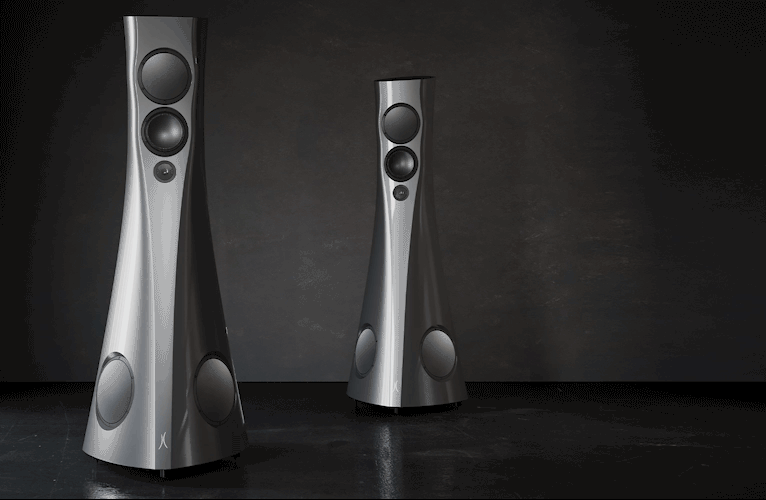The first time I was called an “audio-maniac” was as I was trying to put my left shoe on my right foot at a sake restaurant after a night out in Tokyo with Junji Kimura, the master craftsman of then underground Japanese brand 47 Laboratory. It was the mid-1990s and this then student had travelled to Berlin to study, of all things, Japanese law. But yours truly had an ulterior motive: to stop over in Tokyo on the way home and, with the help of Yoshi Segoshi, the US distributor for 47 Labs, go hang out with Kimura-san and convince him to sell me a Gaincard amplifier and a Flatfish CD transport and Progression DAC at a ‘student’ discount price.
The week I spent with Kimura-san was revelatory. I was in a small home “laboratory”, I think in Kichijoji, with a man who lived with a cutting lathe next to his bed. Listening to his hand- made machines, I felt the ineffable pull of the music in a way I could never had expected from such tiny solid state devices and micro sized single driver speakers. It had soul. It had precision. It had life sadly lacking in much of the high-end equipment I could never afford anyway. Mission accomplished, emotionally connected, I never wanted to leave and have since travelled to Japan at every opportunity exploring particularly Japanese audio culture’s enduring fascination with artisanal directly heated single-ended triode amplifiers (DH SET) and high efficiency horn loudspeakers.
Re: Person I knew
Kimura-san was an established audio engineer who had spent most of his professional life working for many of the majors including Pioneer, Kenwood, Luxman and Kyosera. But through him, I learnt that Japanese audio-maniacs were not afraid to adopt unconventional, ‘datsuzoku’ approaches not just for the sake of being unique but because they felt forced to create unique products which could ultimately deliver more of the music in fresh ways that conventional audio simply could not accomplish.
The founder of SPEC Corporation, Shirokazu Yazaki, is likewise well worth getting to know. Yazaki-san trained as a mechanical engineer and has been a successful professional audio designer in Japan for over 40 years. As the head of design departments at TEAC and Pioneer, he was responsible for many significant achievements including, for TEAC, the A-7300 open-reel tape recorder and for Pioneer, the CT-95 cassette deck, which is said to have surpassed the fabled Nakamichi Dragon, as well as the award winning DV-AX10 DVD player, the world’s first really universal – and first really musical – high-end disc player.
On the home front, meanwhile, Yazaki-san has spent a lifetime continuing to refine his personal audio system based upon audio-maniac artisanal GEC DA30 tube based SET amplifiers (superior in high frequency response to the Western Electric 300B) and an ONKEN wood horn speaker system.
It’s been a nagging question for me for some time: Does modern high-end Hi-Fi – with its pursuit of a sound that expands on or behind the plane of the speakers by emphasising the feeling of elaborateness, wide range, and positioning, with a rather thin tonal quality, and its high degree of perfection from the viewpoint of audio measurements – really bring us the joy and excitement of music?
Yazaki-san’s fascinating “My private history of audio” is published by the great Polish writer, Wojciech Pacula, who first introduced SPEC Corporation to the West in English translation on the High Fidelity website. See also Jeff Day’s wonderful piece in Positive Feedback Online. 6 Moons as well. Let’s just say, while still the head of R&D at Pioneer in 2006, Yazaki-san was exposed to a demonstration of then new D-Class amplifier devices and was very impressed by the sonic potential of the new platform:
Using his non-feedback SET amplifier as a reference, Yazaki-san began developing a Class-D amplifier of his own with the assistance of Jun Hondo, a former colleague at Pioneer who had immigrated to the US and was developing a dedicated audio Pulse Width Modulation (PWM) device for the International Rectifier company in LA. Together with electrical engineer Tsutomu Banno and mechanical engineer, Yasuhiro Yamakawa they founded the SPEC Corporation in February 2010.
In correspondence, Yazaki-san writes of his statement of intent for his “Real-Sound” amplifiers:
Strange to say, but a well-built tube amplifier’s sound and our latest Class-D amplifier’s sound is so hard to make a distinction for me, and only the sound of a linear semiconductor amplifier must be unorthodox for my hearing. How the joy of music would grow if the current mainstream speakers with wide range but low efficiency can reproduce higher-dimensional acoustic sound like old vintage high efficiency speakers. In the development of “Real-Sound” amplifiers, I have tried to make it possible to reproduce a tone that is beautiful, rich, and penetrating, as if appealing directly to the human emotions, a real three dimensional field, and a musical sound full of dynamism! “Real-Sound” might be a faraway dream, but we may reach it by finding out and advancing vintage wisdom with the latest technology.
I’m jumping the gun but if deep, beautifully saturated tonal colours, realistic timbres and great bass grip, drive and control matter to you in an amplifier, of any type, then Yazaki-san and his SPEC Corporation have surely succeeded. Class-D amplifiers are now legion but none to my knowledge sound so effortlessly natural and so non Class-D. Even fewer sound so completely non solid state and so devoid of electronic hash or artifice. Something very unique and ineffable indeed.
Turn Out the Stars
The subject SPEC RSA-M3EX analogue switching Class-D integrated amplifier is the second from the top of a range of predominantly integrated amplifiers. A switch on the back can turn the RSA-M3EX into a dedicated power amplifier but I used the amplifier as intended by its designer (see more below as to why SPEC prefer integrated operation) and felt no need to add a preamplifier. Output power is rated at 60 Watts/8 ohms, 90 Watts/6 ohms and 120 Watts/4 ohms with a tube amp-like frequency response of 10 Hz – 30KHz at +/-1 dB (6 ohms, 1 W). Harmonic distortion is a low 0.02% (1kHz, 80% output power). Despite its ostensible power rating, in use, the RSA-M3EX was capable of extraordinarily sudden dynamic swings and current delivery when required. It maintained seemingly unflappable coherence and composure – and its remarkably natural tonality – even at stupid-approved sound levels and, surprisingly, I never wanted for more power even when driving a difficult load like the Wilson Audio Sasha 2.
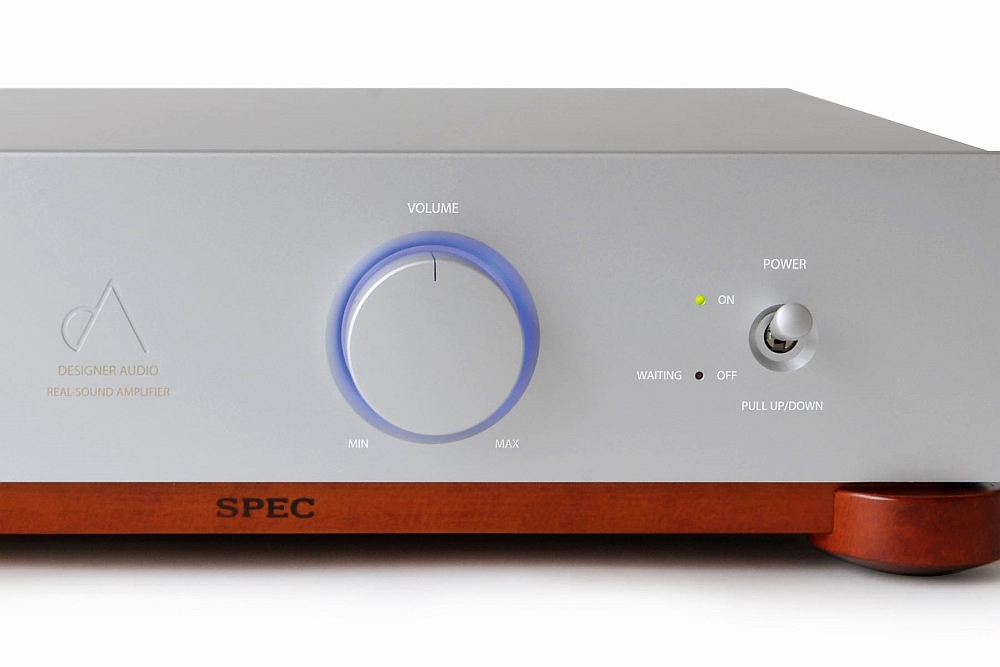
I really love the outward appearance of this satin silver amplifier. Timeless and self-effacing, it has shibui-like economy of line and form with just three knobs on the front panel, a large volume knob, an input selector, and a way-cool toggle power switch with two LEDs, a green one for on and red for mute/off. The volume and input selector knobs are made for SPEC in Japan. The power switch is no ordinary toggle and to turn the unit on or off requires the user to pull the spring locking switch out and then switch it into position. It is derived from professional use, for example in an aircraft cockpit, where protection from accidental switching is mandated. Here, I left it in the on position most of the time as the RSA-M3EX took an inordinate amount of time to burn in, and like many great amplifiers, again takes a bit of time, at least 30 minutes or so, to come on song from power up. The volume control can be illuminated by blue backlight which can be switched off on the back of the unit. But delicate ears and tweeters beware, the same switch at its down most position puts the RSA-M3EX into its power amplifier mode.
The back panel is equally minimalist. The RSA-M3EX has three rhodium plated pairs of RCA and one pair of XLR line level inputs. The amplifier’s internal gain stage is symmetrical and I judged that balanced operation edged out single-ended particularly in terms of ultimate transparency, and tonal and timbrel purity making the most of what is already a vanishingly low noise floor. The speaker connectors are sturdy gold plated types and a mini-jack socket accommodates a cable for the optional extra remote control unit. Purist by design, for the purest of tone.

Japanese audio-maniacs rarely do anything by halves unless it is in the furtherance of good sound by the preservation of the slightest of audio signals. According to the SPEC website, “in some cases, we cut the sleeve of electrolytic capacitor so as not to cause an unwanted vibration”. On the other hand, the SPEC amplifier line is almost uniformly integrated because the company believes the volume control should be laid out close to the power amp stage to minimise the low level audio signal’s susceptibility to noise when located at the preamplifier stage in the chain.
The volume control knob on the front panel of the RSA-M3EX is again no ordinary variable resistor volume controller and is not at all in the signal path. According to Yazaki-san, no signal current flows in this variable resistor. It works as a position-sensitive detector and there’s a very precise electronic volume device that sets the gain of the amplifier according to the detector’s information. This is important for reproducing small audio signals and the sound quality remains consistent no matter the volume level and without any discernible collapse of the soundstage and the size of the sounds within it.
The RSA-M3EX outer casing consists of two layers, a metal one and a wooden base one (which is not just ornamental). Class-D amplifiers are prone to high frequency noise and high gain amplifiers are prone to vibration. Therefore, here, the metal half of the amplifier’s outer casing again consists of two layers, a steel one and an aluminium one, to make the entire housing more mechanically rigid and for optimal shielding and noise elimination. There is more metal screening internally. SPEC claims there is “even a secret to how the spacing and height of surface mount components changes the sound, and to the careful use of shielding and type of shielding. Too much shielding in both RFI and EMI can choke the sound”.
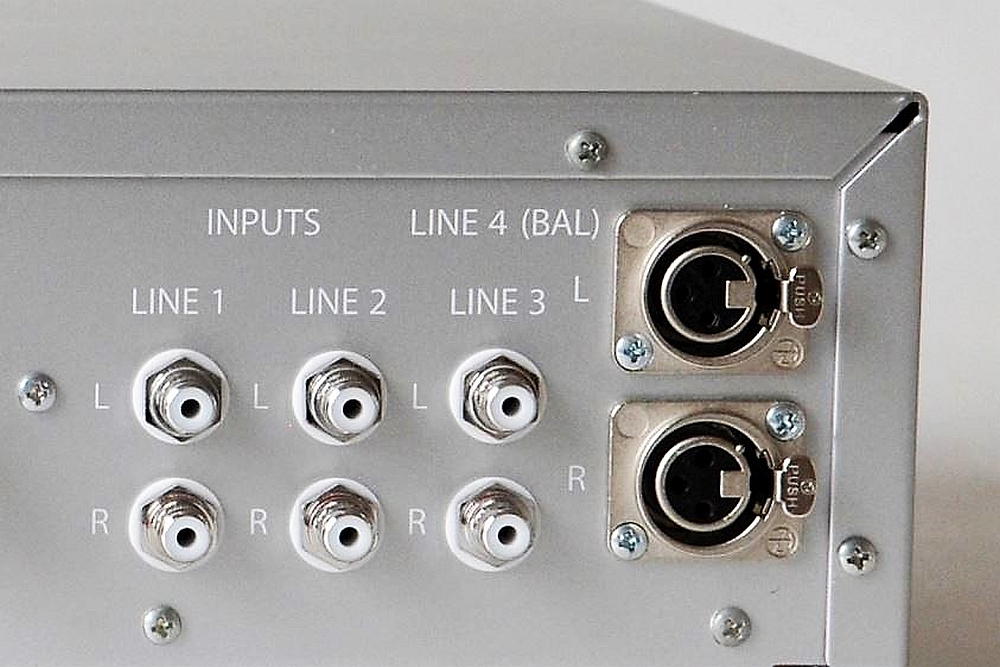
The wooden base platform consists of a solid laminated panel of European spruce from Austria (like the tops of certain choice Custom Shop Martin acoustic guitars, for instance) which not only provides quick transmission of mechanical vibration and moderate rigidity and damping but also contributes a rich and warm “pleasant” acoustic sound that “offers a more natural tonal quality over synthetic man-made materials”. The three footers or “insulators” on the bottom of the wooden base are a combination of real painted maple from Hokkaido, Japan and hickory (as used also by Acoustic Revive).
Zazaki-san and Banno Tsutumo use vintage-type cables like Belden 8402 microphone cable for interconnects and NOS Western Electric WE16GA speaker cable in their home systems and the RSA-M3EX is wired internally with Belden 1503A cable which SPEC felt “in our evaluations to be one of the very best cables for inner signal use”.
It’s all a bit Shun Mook-ist, really, and in actual fact the RSA-M3EX proved to be ‘a wizard, a true star’ when hooked-up to my irreplaceable Shun Mook Bella Voce loudspeakers. I was greatly impressed by the singular way the RSA-M3EX took control of the speaker’s slightly loose and over-ripe bass registers all the while preserving its magical single driver-like coherence in the mid- to high-range.
Glorious Switch, sorry, Gloria’s Step
A high powered solid state amplifier may have the raw driving power that a low powered DH SET lacks for driving and controlling a conventional dynamic speaker. But the transfer function of a typical solid state semiconductor is poor in linearity compared to a tube and needs to be corrected by applying negative feedback. Thinking like the maker of a non-feedback DH SET, Yazaki-san asserts that the negative feedback circuitry applied in a traditional solid state amplifier makes the amplifier stage especially vulnerable to counteractive energy from motion started in the voice-coil of a speaker, causing complicated phase delays and timing errors inside the amplifier and so, “the excellence of Class-D amplifiers is in how they control the inevitable back electromotive force (BEMF) from the speaker. In a Class-D amplifier the current of BEMF is directed back to the power supply but in a traditional solid state amplifier the current enters forcibly into the feedback circuit. That disturbs precise phase transmissions of dynamic music signals.”
Because the DirectFET output device in a Class-D amplifier operates only as a switch, the impedance of the output device during switch-on is very low and therefore the output device can absorb and regenerate this counter electromotive force directly and very efficiently through the switch. This manner of high efficiency bi-directional energy transfer reduces the need for a negative feedback loop and enables more accurate drive of the speaker with excellent linearity.
A logical extension of the SPEC ethos in this respect and another demonstrable reason for the adoption of Class-D by SPEC is the RSP-901EX “Real Sound Processor”, a type of passive filter box which attaches to the speaker terminals. It has two major functions, the first is to improve an amplifier’s performance by reducing fluctuations in a speaker’s impedance which varies with frequency so as to drive the speaker more easily. The second is to again absorb counter-electromotive current from the speaker thereby making it possible for an amplifier to drive the speaker with more fidelity to the input signal. In my system, it made a worthwhile and meaningful difference, more so, predictably, with solid state than tubes, less so, curiously, with the RSA-M3EX itself. It subtly enhanced, deepened and intensified just about everything: space, tonal density, timbrel texture, ease, ultimate musical involvement, and is worthy of a review in its own right. Highly efficient and effective Japanese ‘audio-mania’.
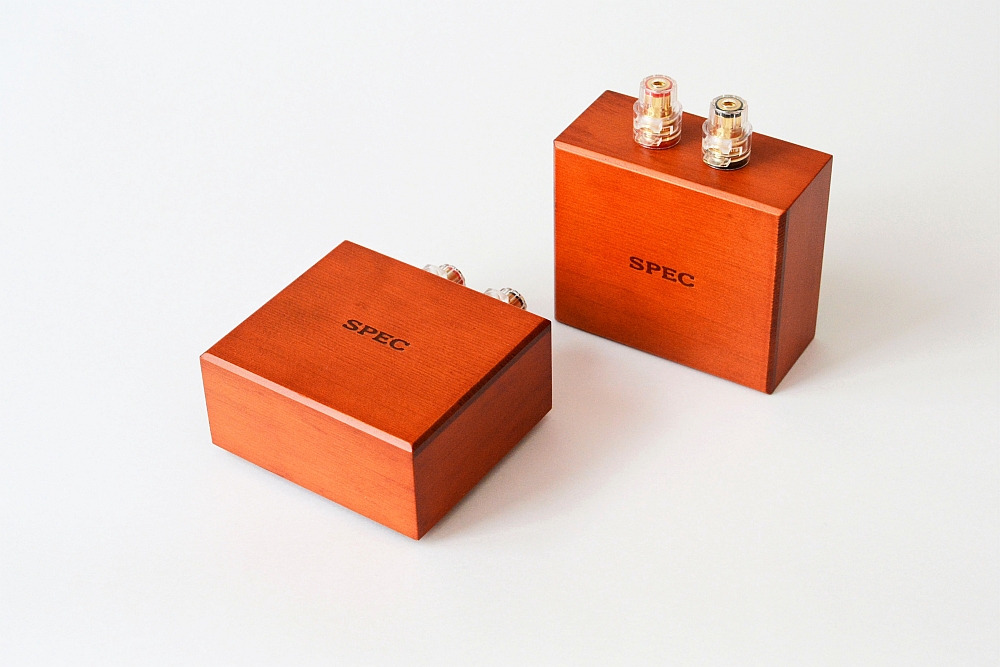
Class-D operation also has the advantage that it provides instant current delivery. Further, because Class-D uses switching technology, the power stage doesn’t generate wasted heat. It has almost triple the efficiency of conventional semiconductor amplifiers but a Class-D amp is very sensitive to the quality of the power supply. Here then, like a great tube amp, the RSA-M3EX has a heavy and substantial R-core toroidal power transformer which occupies much of the internal real estate and is manufactured by Kitamura Kiden which also supply analogue transformers to Esoteric.
It seems to me, that SPEC Corporation has ingeniously taken the entire DH SET high efficiency speaker paradigm and shifted (switched?) the high efficiency operation of that system from the speaker to the amplifier to give users of current mainstream speakers with wide range but low efficiency that taste of DH SET sound and tone. And, what especially distinguishes the SPEC “Real Sound” from other Class-D mavens is its masterly application of vintage tube know-how and craft to the most crucial aspects of a Class-D amp itself.
Rather than use OEM Delta Sigma modulation for the beating heart of the RSA-M3EX, SPEC uses the PWM International Rectifier IRAUDAMP4 DB modulator. The PWM method according to SPEC “doesn’t digitize input signal. PWM doesn’t use A/D converter. We think of it as an ‘Analogue Amplifier’ with 400Khz switching”. It is, in effect, an analogue circuit with a short, simple signal path that controls the output power FETs with kanso-like precision. Yazaki-san states that the output devices developed by Hondo for the IR audio amplifier device:
Achieve highly accurate current switching in the power stage, and a high-voltage gate driver IC with excellent time-axis control maximises the ultimate PWM switching. The exceptional performance of these class - D devices ensures ultimate real sound with quality damping in the mid to low ranges even when driving low-efficiency speakers. Furthermore, the sweet and rich tonal character in the mid to high ranges of the amplifier is almost like the tone of the very best triode tube amplifiers.
Equally crucial to the RSA-M3EX’s success is SPEC’s strategic tuning/voicing of the final reconstructive analogue low-pass filter stage which has to be installed at the output of a Class-D amplifier in conjunction with a snubber circuit which is used to suppress voltage spikes when the switch opens. Here, SPEC is at its most tube audio-maniacal and uses ultra-refined proprietary hermetic seal oil-filled capacitors and exotic custom mica capacitors built with laminated construction to minimise inductance so capacitance does not change until the MHz band.
The hermetic seal capacitors, which SPEC took years to source and now distribute in Japan, are by Arizona Capacitors in the US and are replicas of now unobtanium vintage WESTCAPs and which Yazaki-san now also uses in his valve amplifiers. And if you still had any doubt about SPEC’s attention to detail, the RSA-M3EX uses both a C85805 KP/AL/mineral-oil type capacitor and a C30509 KP/MY/AL mineral oil type because, as Yazaki-san notes, “The C85805 has an extremely beautiful saturated midrange and treble to be perfectly matched to female vocals and stringed instruments like the violin. The sound is graceful and pure.”
Last but not least, the choice of rectifier diode is a Schottky silicon carbide (SiC) type which not only has “a very high speed bass and a completely noise-free treble” but which Yazaki-san felt “the sound of this diode performed much like a high-quality tube rectifier”.
Waltz for Debbie
All this ‘high SPEC tech’ would count for nothing, of course, if the thing didn’t sound bleeding edge incredible. Which it does. Not just for a Class-D amplifier but for an amplifier of any type, and, in this writer’s opinion, at anywhere near the price. The thing is a pure tone machine that captivates on all types of program and on most any reasonably efficient speaker. The RSA-M3EX has remarkable tone density, saturation and timbrel realism which it presents with an effortless immediacy and with a startling sense of authenticity. Like a great 300B, its midrange is world class; relaxed, liquid, and positively entrancing. But it also has tremendous scale and drama. Its bass is prodigious but taut and supple and with great speed and grip. Naturally open and seriously dynamic, the thing is the real deal and complete package.
For starters, the RSA-M3EX has a way with the human voice that is simply exhilarating. Whether that voice is the cracked, burning hurt of Billie Holiday on Songs for Distingué Lovers or of Justin Townes Earle hurtin’ in his reimaging of (and “Day In, Day Out” identification with) Lady Day on “White Gardenias”, this amplifier connects you directly to the singer with pure, unmediated, high efficiency emotional connection that makes your hair stand on end.
Onto the player goes the aptly titled Cool Heat by the inimitable Anita O’Day. Through the RSA-M3EX, O’Day’s distinctive, ‘vibrato-less’, vocal delivery is exquisite. Modulating between scat rhythms and swelling crescendos, O’Day’s expressive vocal is vividly alive and swinging informed by the dense, rich tone and abundant timbrel information and illumination on offer. Imaging is tangible but here it is not a typical solid state sharply-etched static image. (If anything, as in live performance, image outlines are just a little diffuse). Imaging is, however, life-like in size and accurate in location. The backing orchestra is likewise no less palpably realised or clearly resolved. The RSA-M3EX’s separation of individual instruments, each with its own unique tone, timbre and sound activity, is phenomenal. On “Hershey Bar” for instance, Art Pepper’s alto sax solo penetrates with uncanny realism. Bass extension and power is magnificent and integrates seamlessly into the sweet, liquid, tube-like midrange. Dynamics and scale have an unforced effortless quality that jump and swell often taking the listener completely by surprise. The whole (of the) sound is so relaxed and coherent that when the orchestra plays tutti, the amount of volume suddenly reproduced is tutti breathtaking.
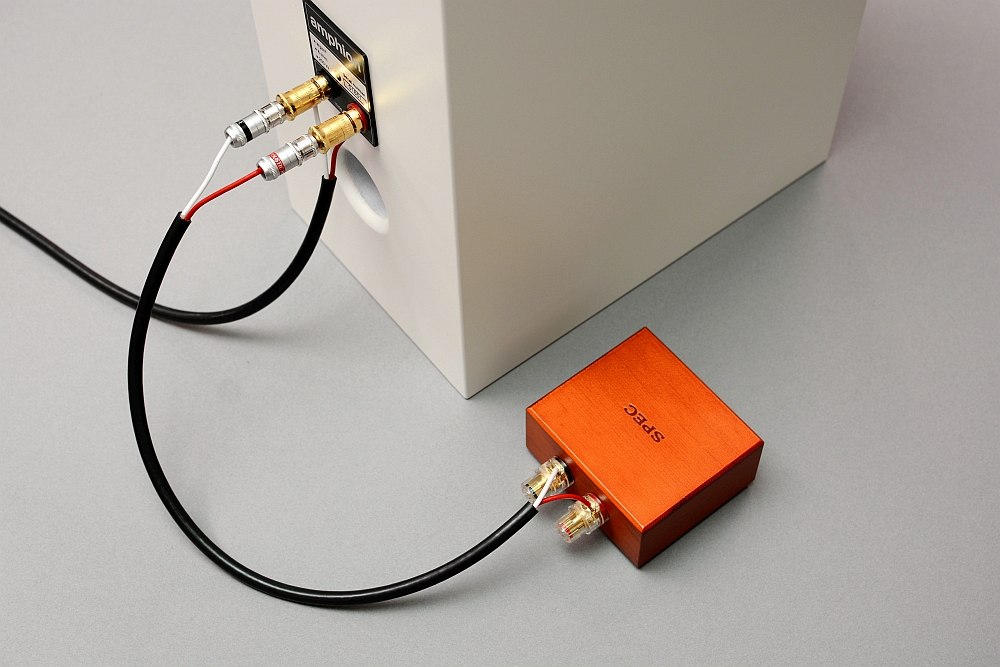
The treble is smooth, extended and detailed. Fatigue free, it is perhaps, just a tad warm and rounded. Depth perspectives are perhaps slightly curtailed but the listening experience is perhaps rendered all the more ‘stereoscopically’ intimate as a result. Through the RSA-M3EX, the soloist too seems to take a step back towards the orchestra making the whole performance feel much closer to live and is very intense, immersive and involving. Kind of like the work of a great 300B (or DA30). This is also a neat example of how RSA-M3EX uses hitherto Class-D limitations such as a slight foreshortening of depth to serve its ultimately musical ends. Individual images don’t just pop in 3D through the RSA-M3EX, the whole sonic presentation seems to. Soundstaging is otherwise very broad and notably tall.
I first experienced the monumental Japanese experimental psych rockers, Boris, around the time of their second album Amplifier Worship in Tokyo in the late ‘90s. Now 23 albums in, they continue to be one of my all-time favourite bands of the last 30 years. I scored the awesome Boris performing “Flood”, a classic Boris long song, from their ‘merch’ desk after a great performance at the Unit Club in Shibuya a few years ago. The CD is a 36 minute track recorded “live directly from the soundboard without further editing or post-production” and sounds wonderful. Over the course of the song, we pass through all the many aspects of a band who can segue artfully from avant-garde ambient noise to Nick Drake alt-tunings to Sabbathy sludge to shoe-gazey pop and more. The track opens with a squall of feedback noise and crying guitars before modulating into succeeding passages of often quite lyrical psychedelia and beyond.
The RSA-M3EX gets it. And gets it powerfully. Frequency response is awesome. Transient attack is ever so slightly rounded contributing substantially to a warm, inviting ‘they are here’ perspective (rather than a ‘you are there’ clinical master tape-type one). But, critically, flow and PRAT, which can be very fluid and elastic on this track, are in no way impeded. The RSA-M3EX has great toe tapping rhythmic insight. Resolution of detail is wholly and musically satisfying. The RSA-M3EX is incredibly transparent and revealing, even when Boris is at its most sludgy and noisy. Cymbals shimmer with authentic realism and ambient life, voices breathe and heave, guitars, variously clean and processed, variously sweet and sour, jangle, then grind, then soar with wonderful micro- and macro dynamics. Bass is fast, deep and taut. It may lack a smidge of inner detail but only when compared to the amplifier’s spell-binding, world class midrange. The RSA-M3EX excels at massive scale and drama but is so even handed and balanced that no particular frequency across its broad spectrum is foregrounded, no one Hi-Fi aspect is relied upon to artificially heighten musical enjoyment. Like a great DHT SET amp, it captivates by illuminating the music’s inner structure, harmony and meaning, by flooding the listener with scores of realistic timbrel information and tonal density, with saturated insight into the soul and intent of the musicians.
The overall tonal balance is ever so slightly warm but, curiously, not necessarily across the different instruments in this recording (or for that matter, across different recordings). This is not a ‘fake-warm’ solid state amplifier seeking to mimic tubes by imbuing everything with a homogenizing fake-smooth warming glow. Nor does the RSA-M3EX imbue everything with a typical Class-D-like chocolatey or velvety synthetic sheen. The RSA-M3EX is much too transparent and tonally refined for that. This is an exceedingly precise, linear, and wide bandwidth sound; one that is teaming with musical energy, dynamic life and colour.
And last but not least, for all these reasons, the RSA-M3EX positively digs Bill Evans. Positively digs the complex dynamic interplay and rich musical delights of this virtuoso who from his Live in Paris Vol 1 LP provides the subtitles to this review. Evans’s earlier classic Sunday at the Village Vanguard was transformative in its day. Rather than foregrounding and showcasing Bill Evans as the only soloist with backgrounded rhythmic accompaniment, the Bill Evans Trio on “Sunday” according to Thom Jurek in AMG developed a complete interactive experience, with all three musicians “in an aural basket weave”. An aural metaphor, perhaps, for the way this ground-breaking “Real Sound” amplifier makes such great music.
What Are You Doing the Rest of Your Life?
The RSA-M3EX is one remarkably pure sounding tone machine. It has bass extension and power enough to drive a range of lower efficiency real world speakers and gives a taste of the characteristic deep rich tone and musical dynamic sound activity that was previously the domain of DH SET amplifiers and high efficiency loudspeakers. It has precision. It has serious scale and a versatility that consistently delivers on anything you might throw at it. And always, it has supreme musical involvement and fresh insight.
It transcends its Class-D and/or uses Class-D characteristics to further deepen and enhance the musical experience. It has a felt sense of natural ease that eludes most solid state amplifiers. It is exceedingly transparent and has a marked absence of glare, etch or stridency. Indeed, there is absolutely no listener fatigue at all. Further, as I write this, we are in the midst of an unseasonably extreme heatwave and we are rather grateful for its high-efficiency operation.
Like its sonic references, the amplifier captivates with an emotional pull and sound activism that has few peers at any price. It is positively addictive. I would expect nothing less from a Japenese audio-maniac with Yazaki-san’s experience and sophistication.
If the top of the line, more than twice as expensive RSA-F33EX, has even more of these tantalising DH SET inter-stage amplifier-like transcendent qualities then please put my name on the list for a review sample immediately. Because, as I approach the end of the review period, I really don’t want to have to return this unique and really rather special “Real Sound” amplifier. Consummately recommended. Ichiban!
…Peter Katsoolis
Associated Equipment
- Amplifier – VTL MB 185 Signature Series III; Pass Labs XA25
- Preamplifier – VTL 6.5 Signature Series II; CAT SL1 (phono stage only)
- Sources – Oracle Delphi Sumiko The Arm Lyra Titan I; Aqua Acoustic La Diva CD Metrum Acoustics Hex DAC; Auralic Aries Streamer
- Speakers – Wilson Audio Sasha 2; Shun Mook Bella Voce; Audio Note AN/J; Redefy Audio Monitor (in for review)
- Cables – Vermouth Audio; Nordost Heimdall 2; HiDiamond cables (in for review)
SPEC Corporation RSA-M3EX Integrated Amplifier
Price: AU$12,995 (RSP-901EX AU$1295)
Warranty: Two years
Australian Distributor: Audio Heaven
+61 (0) 412 650 723
www.audioheaven.com.au
SPEC Corporation
Level 4, Nihombashi Nakaya Building
12-12 Nihombashi-Kobunacho, Chuo-Ku,
Tokyo 103-0024, Japan
+81 (3) 3660 0303
www.spec-corp.co.jp








